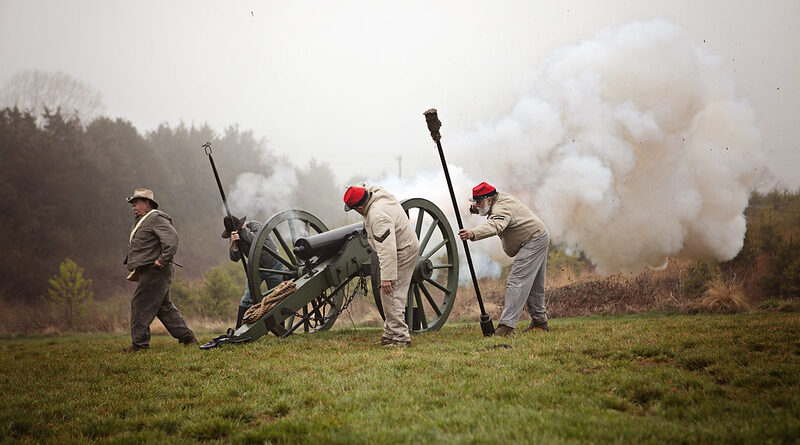The American Civil War
A house divided against itself cannot stand.
I believe this government cannot endure
permanently half-slave and half-free.
— Abraham Lincoln, 1858
What Was The American Civil War?
A war fought in the United States between the North (Free States/Union/United States of America) and the South (Slave states/Confederacy/The Confederate States of America). There are multiple reasons for the start of the War, but the most notable outcome of the War was the abolition of slavery in the United States of America.
Slave states, states that legally had slaves, wanted to continue slavery so in a last effort to secure their right to slavery they seceded from the United States of America and created the Confederate States of America.
Why Did The American Civil War Start?
Slave states refused to accept the election of Abraham Lincoln as President. Lincoln was outspoken about the abolition of slavery, a concept, if carried out, that would crush the economy of the South.
Tensions between the North and the South continued to grow from a multitude of reasons including the North’s industrial capacity vs. the South’s agricultural ways, states’ rights vs. federal rights, and most notably the North’s push to abolish slavery vs. the South’s pursuit for the right to continue slavery.
The culmination of differences could no longer be appeased by laws passed in Congress. On December 20, 1860, after the Presidential Election of Abraham Lincoln, South Carolina was the first to secede from the Union followed by Mississippi, Florida, Alabama, Georgia, Louisiana, and Texas.
The seven states to secede created a national government, the Confederate States of America, by February 1861 located in Montgomery, Alabama (the capital would later move to Virginia) with Jefferson Davis as the President. The Union did not fully acknowledge the secession of the Confederates States of America because the act of secession was thought to be nearly illegal by the terms defined in the creation of the United States of America.
First Shots
Less than a week after South Carolina announced its secession from the Union, Major Robert Anderson left Fort Moultrie, located on the shores of Charleston, under the cover of night to Fort Sumter, an island in the harbour of Charleston, for better defence. South Carolina and the Confederacy demanded the abandonment of Fort Sumter by Anderson and his men. Any attempts by the Union to resupply the Fort were stopped.
President Lincoln, under great pressure to keep the country intact, sent a dispatch of troops to Fort Sumter for much needed supplies and additional troops to settle the matter. The first of the ships arrived April 11, 1861. The South considered the movement of troops and supplies as an act of provocation and retaliated.
On April 12, 1861 the first shots rang out in the harbour of Charleston, South Carolina as Confederate troops opened fire for over twenty-four hours in the direction of Fort Sumter.
What Happened Next?
Once the War officially started, President Lincoln ordered troops from the surrounding states to send militia to stop the Confederates in Charleston. Followed by Lincoln’s order, four more states seceded from the Union: Virginia, Arkansas, Tennessee, and North Carolina.
Who Fought On What Side?
The chronology of states that succeeded and joined the Confederacy included: South Carolina, Mississippi, Florida, Alabama, Georgia, Louisiana, Texas, Virginia, Arkansas, Tennessee, and North Carolina.
The states, border states, and territories that supported the Union included: California, Colorado (territory), Connecticut, Dakota (territory), Delaware (border), Illinois, Indiana, Iowa, Kansas, Kentucky (border), Maine, Maryland (border), Massachusetts, Michigan, Minnesota, Missouri (border), Nebraska (territory), Nevada, New Hampshire, New Jersey, New Mexico (territory), New York, Ohio, Oregon, Pennsylvania, Rhode Island, Utah (territory), Vermont, Washington (territory), West Virginia (border), and Wisconsin.
Where Was The First Major Land Battle Of The War?
On July 21, 1861 the Battle of Bull Run, also known as the First Battle of Manassas, was the first major land battle between the Union and the Confederacy. The Union expected the battle to be the first and only battle to occur during the War. Unexpected by the Union, the Confederacy won the battle because of unprepared Union troops and a strong Confederate military leader, Thomas Jackson, who earned his famous nickname Stonewall Jackson.
What Other Major Battles Occurred?
Battle of Antietam: On September 17, 1862 Unionists and Confederates experienced the bloodiest battle of the War. In a single day over 23,000 soldiers were killed in action. The battle marked the end of the Confederacy’s first invasion into the North led by General Robert E. Lee.
Battle of Gettysburg: July 1- 3, 1863 marked the bloodiest battle of the American Civil War with approximately 51,000 casualties. The battle is also known as the turning point in the War favouring the Union. The Confederacy’s strategy changed from offensive to defensive when General Robert E. Lee’s second invasion into the North failed.
Battle of Vicksburg: Only a day after the end of the battle of Gettysburg, on July 4, 1863 the Union captured the city of Vicksburg, Mississippi under the direction of General Ulysses S. Grant. The loss of Vicksburg divided the Confederacy along the Mississippi River.
Battle of Chattanooga: The Union victory on November 25, 1863 granted William T. Sherman the Atlanta Campaign and the March to the Sea, which destroyed the Confederacy’s infrastructure from Atlanta, Georgia to Savannah, Georgia.
Battle of Appomattox: Two years after the major turning points in the War, Confederate Robert E. Lee surrendered to Unionist Ulysses S. Grant on April 9, 1865 at the Appomattox Court House.
Importance Of The American Civil War
The American Civil War remains the bloodiest war in American history with approximately 620,000 casualties. The casualty amount would not be equalled until the First World War, Second World War, and the Vietnam War casualties were totalled together.
The War also formally ended slavery in the United States of America by the Emancipation Proclamation the South’s surrender, and Reconstruction.
The Gettysburg Address
At Gettysburg on November 19, 1863 four months after the deadliest battle of the Civil War, President Lincoln gave a remarkable speech at the dedication of the Soldiers’ National Cemetery. President Lincoln referred to the human rights stated in the Declaration of Independence and the new focus of the Civil War to be a struggle for the preservation of those basic human rights. His speech would become known as one of the most famous speeches in American history.
President Abraham Lincoln
Fourscore and seven years ago our fathers brought forth on this continent a new nation, conceived in liberty and dedicated to the proposition that all men are created equal.
Now we are engaged in a great civil war, testing whether that nation or any nation so conceived and so dedicated can long endure. We are met on a great battlefield of that war.
We have come to dedicate a portion of it as a final resting place for those who died here that the nation might live. This we may, in all propriety do.
But in a larger sense, we cannot dedicate, we cannot consecrate, we cannot hallow this ground. The brave men, living and dead who struggled here have hallowed it far above our poor power to add or detract.
The world will little note nor long remember what we say here, but it can never forget what they did here. It is rather for us the living, we here be dedicated to the great task remaining before us–that from these honored dead we take increased devotion to that cause for which they here gave the last full measure of devotion–that we here highly resolve that these dead shall not have died in vain, that this nation shall have a new birth of freedom, and that government of the people, by the people, for the people shall not perish from the earth.




